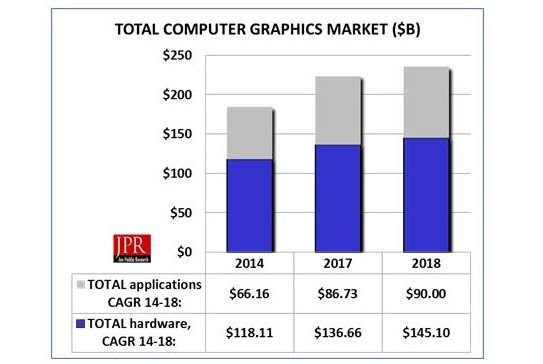New Jon Peddie Research update shows graphics a continuing driver of computer industry growth.
The computer graphics industry has been a growth industry since it was established in the late 1970s. It has weathered the storms of recessions and has emerged with renewed vigor and potential, partly due to a big boost from mobile and the move to 4K, but also from emerging technologies including 3D scanning, 3D printing, augmented reality, and virtual reality.

The computer graphics hardware market was worth $105 billion in 2014 and is expected to exceed $129 billion by 2018, with software growing slightly faster than hardware.
The hardware segment of the CG industry has enjoyed steady growth, and even though the overall PC market dropped by 12% over the past year, workstations, monitors, and PC gaming have seen steady to strong growth. The total PC gaming hardware market (which includes aftermarket sales and peripherals) is estimated to be worth over $30 billion. New activity in APIs with developments like DirectX 12, Khronos Vulkan, Google’s driver extensions for OpenGL ES, and Apple’s Meta in 2015 all will contribute to faster, richer, and higher resolution graphics for everyone.

In 2014 the CG software market was worth $66 billion (not counting services, maintenance and other aspects) and is expected to grow to $90 billion by 2018 through a combination of end-user software such as games (which are real-time, high-resolution simulation systems), and content creation software tools. The software suppliers (ISVs) have also changed their sales model moving more services to the cloud.
JPR expects traditional segments like CAD/CAM to expand as new design approaches in automotive, aerospace, and architecture are adopted. The visualization market is showing significant growth due to the availability of more powerful and less expensive visualization technologies. GPU compute employing OpenCL and CUDA is penetrating further into new as well as traditional applications.

The demand for programmers, artists, scientists, and designers has picked up and we’re seeing startups arrive in emerging and reborn markets such as augmented reality, virtual reality, and casual games. The arrival of new APIs, and platforms are also stimulating development. Firms are actively looking for people who can use and exploit these new programs and their associated hardware accelerators.The software content creation market has been tough for the market leaders. They’re living with a mature market, with little growth, but stability among the competitors. However, there are new opportunities emerging as new approaches to content creation become practical, new distribution channels open up, and young generations arrive with a new fascination for 3D.
New opportunities are also growing out of mainstream applications for the web and consumer applications. The social web remains a strong engine for growth. Social networks are encouraging people to learn new tools, create content for pleasure, and even look for jobs in the field. What used to be a very closed society of experts is now opening up due to the democratization of CG, fueled by Moore’s Law and price-elasticity due to lower software costs.
Given the trends in dropping costs, and the increasing users and usage of CG tools and hardware, JPR predicts the rate of growth for the CG industry will remain fairly steady for the foreseeable future. Computer graphics is truly a worldwide industry now. JPR will have a press-only discussion on this topic at Siggraph in Los Angeles on August 12th at noon – all press are invited. Details and registration here: JPR SIGGRAPH Luncheon





